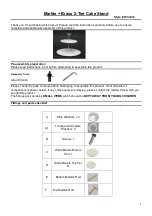
Cleanfit P CPA472D
Maintenance
Hauser
23
5.3
Cleaning agents
The selection of the cleaning agent is dependent on the degree and type of contamination. The most
common contaminations and the suitable cleaning agents are listed in the following table.
"
Caution!
Do not use organic solvents containing halogen or acetone. These solvents could destroy plastic
components of the assembly or the sensor and it is also partly suspected that they cause cancer
(e.g. Chloroform).
5.4
Replacing seals
To replace the seals of the assembly you have to interrupt the process and to remove the assembly
completely
#
Warning!
Beware of medium residues and higher temperatures when handling components that were in
contact with medium. Wear protection gloves and protection glasses.
Clean the assembly before replacing the seals (see chapter "Cleaning the assembly").
Preparation:
1.
Interrupt the process. Beware of medium residues, residual pressure and higher temperatures.
2.
Move the assembly to the "Service" position. Secure this position by the stop lock bolt.
3.
Dismount the sensor.
4.
Dismount the assembly from the process connection.
5.
Clean the assembly (see chapter "Cleaning the assembly)
Dismantling the assembly
1.
Remove the clip-on raising face. Use a screw driver to loosen the raising face (see Fig. 19).
2.
Loosen the four bolts (see Fig. 20) and remove the flange and the rinse chamber.
3.
Unscrew the retractable pipe (counterclockwise).
4.
Unscrew the electrode.
5.
Release the stop lock bolt.
6.
Pull the electrode holder out of the bottom side of the assembly body.
7.
Loosen the four bolts of the cylinder head and remove the cylinder head.
Type of contamination
Cleaning agent
Greases and oils
Hot water or tempered substances containing tensides (alkaline)
1)
or water-soluble organic solvents (e.g. Ethanol)
1)
do not use for Tophit ISFET sensors! Instead, use commercially available acidic cleaning agents for the food industry
(e.g. P3-horolith CIP, P3-horolith FL, P3-oxonia active).
Calciferous deposits, metal hydroxide deposits,
lyophobic biological deposits
Approx. 3% hydrochloric acid
Sulphide deposits
Mixture of 3% hydrochloric acid and thiocarbamide (commercially
available)
Protein deposits
Mixture of 3% hydrochloric acid and pepsin (commercially
available)
Fibres, suspended substances
Water under pressure, poss. with surface-active agents
Light biological deposits
Water under pressure
















































